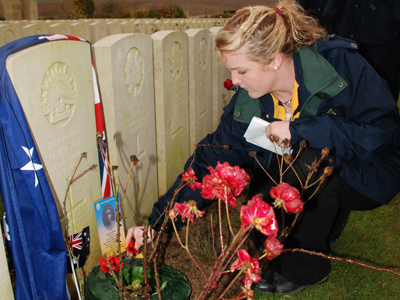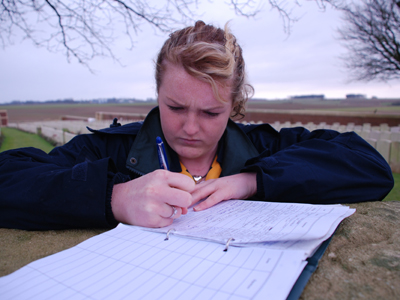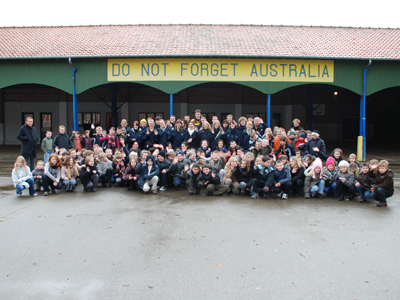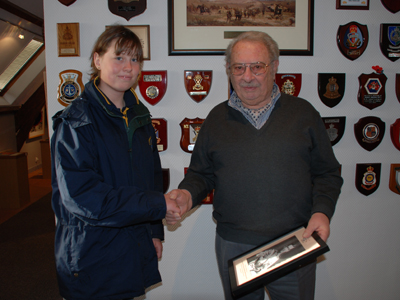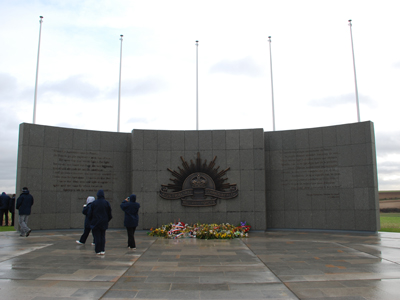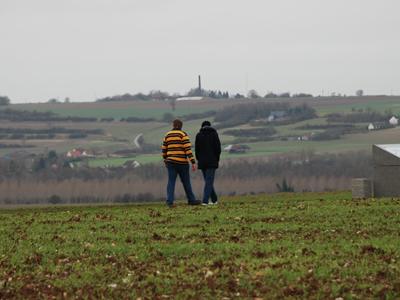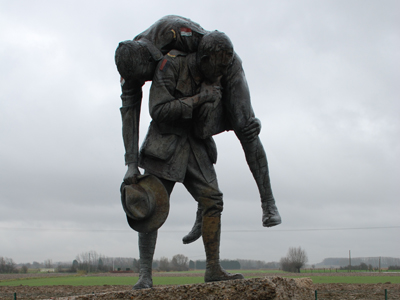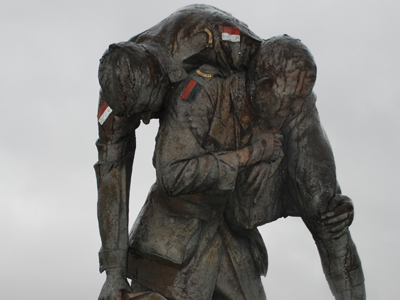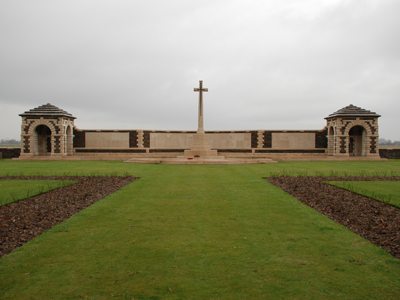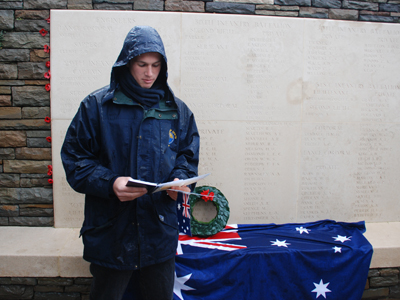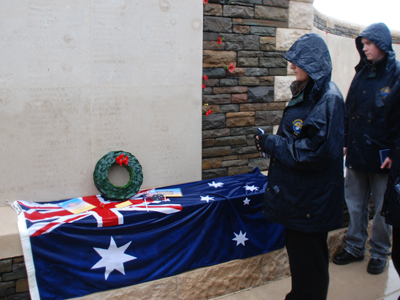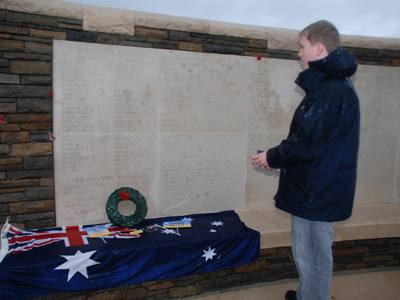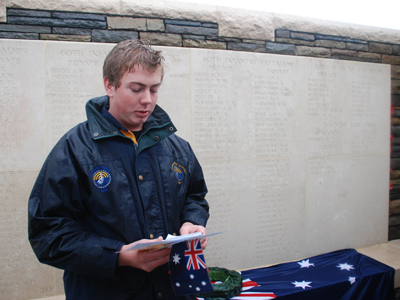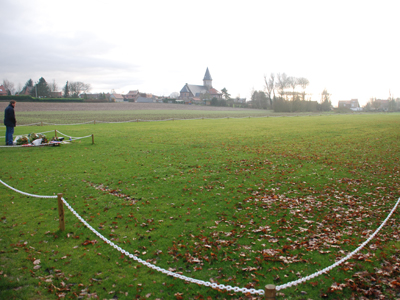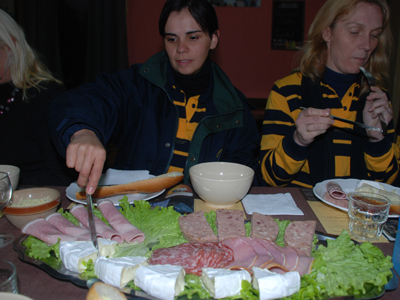Dec 5
Friday December 5: Amiens – Fromelles- Ieper
Yet another early start and the darkness of the morning and the rain made for a grey beginning. Having visited Arras the other day we had a fairly straight forward run though to northern France and Belgium. First stop was the cemetery at Puchevillers to commemorate Osborne Wilson, as we ran out of time the previous day. We then visited the school at Villers Bretonneux and spent some time playing with the kids before heading up to the museum. After looking around at the extensive collection, Bethany presented the museum with a photo, on behalf of the Duke of Leinster Lodge, of William McKay, who was a member of the lodge killed on the 24th April 1918 in the attack to liberate the town from the Germans. Then a quick and cold visit to the Monash Memorial, at Le Hamel, which has been completely rebuilt since our last visit. From there it was north to Fromelles and the slaughter of July 19 -20th 1916. Lunch was at a very large service centre across the major freeway where we could yet again attack the veggie counter. Spinach, carrots, green beans and even eggplant….divine! Fed, watered and fuelled up (all 420 litres!!!!!!) we were on the road.
The conditions were appalling with steady rain falling and the sky was eerily dark. The mood of the place matched its tragic past. This place makes me angry. To learn from Rod that there was a communication from Haig to the two commanders Haking and MaCay that the attack was to be called off due to the lack of progress on the Somme, and that the whole debacle of Fromelles had even less reason to go ahead, was just gob-smacking. We drove around the various back roads or should I say tracks, putting together the story of July 19 and 20. Here our bus driver and his beloved bus ‘Bessie’ showed what they were made of. All through the village of Fromelles and surrounding villages, the roads are framed by deep drains as the water table is very close to the surface. Nowhere is dry. As Rod would direct Richard to take poor Bessie around the next ‘short cut’ he would make these amazing turns on a pin in the middle of cabbage fields and those drains were always there tempting fate! However Richard just calmly judges the distance to millimetre precision – he knows what he’s doing. This place is basically a swamp: more empathising with the conditions our WW1 boys would have endured. Our main stop at Fromelles was VC corner where we commemorated four soldiers Scott, Bennett, Brooks, and Stead.
For the first time in years we were actually early to Fromelles and broke the bad habit over previous years of turning up late much to the wrath of my Froggy mate, Carole Laignel. However in 2008 we were on time. Hugs and kisses abounded as a friendship that is only renewed every two years was reignited. As in previous years these overseas friendships are full on while you are with each other then all of sudden it is time to depart. Fraught! Following the commemorations at VC Carole took us to the now famous Pheasant Wood the site of the mass grave of 400 of the missing from the battle. The mud was unbelievable; sticky, gluey and everywhere. Treading carefully was not enough for our beloved Flo as she did a slip and a slide and over she went. Ugh! Eventually we made it the fenced off site where the 400 bodies lay; the location being confirmed in the first part of the year. A simple plaque marked the site surrounded by floral tributes. Carole recounted the regular visits she made while the pit was being exposed and shared the deep emotions as these men were found. There is a debate surrounding the ultimate outcome of these men with one school of thought being that the pit should not be touched and the men left where they were buried over 90 years ago. Contrasting this is the belief that each of the 400 men should be identified with their own grave as in other Commonwealth War cemeteries. It is hard to know what the most appropriate course of action is, but I know that if one of my relatives was in the pit I would like to have a grave to mark them. The late afternoon sun decided to appear and for the first time in ages the light was beautiful. Soft European sunshine filtered by the trees made for a unique and strangely calming affect. Walking back along the makeshift path I copied Flo’s efforts on the mud and over I went. Grrrrrrrrr….What a mess. My boots were sodden, jeans covered in mud and socks absolutely saturated. Oh well regard it as a way of empathising with those of the past! Across the road we saw the site where the new cemetery will be constructed to rebury the 400. After reading all the reports and viewing the television footage of the Fromelles dig it was eerie to be here. With plenty of time up our sleeve we made our way to the local museum and viewing of some WW1 slides that Martial Delabarre shared with the group. A lovely surprise for me again as Carole’s daughter Dorothy dropped in for a brief visit. We didn’t have much time together, brief but sweet. Dot spent time with my family in 2000 and attended my school as an exchange student. At 16, blonde, funny and bright she made an immediate impact. My young son Pat was 17 at the time and he thought he had died and gone to heaven! Mmmm….Dot became part of our family and has always been special to the Reeces. A quick hello and then it was goodbye. More of this overseas separation stuff. Hard.
Our evening meal was at the local café next to the church and Carole had negotiated with the new owners to provide dinner for our large group. This was a special favour and we were treated to a feast. Platters of terrines, meats, chunks of soft camembert and yummy French breads were just the start. Hot bowls of home made carrot soup soon followed. To complete the meal coffee with tiny pots of crème brulee accompanied by a piece of chocolate cake, made for a stunning meal. The mood was wonderful. Carole told me of the large barn at the back of the café and how up until two months ago, was the local cock fighting centre. Ugh! Saying goodbye to Carole was its normal teary affair however at least this time I will have a whole day with her in Paris when the kids go to Euro-Disney. Left for Ieper and had a very quiet journey to the hotel. The little darlings were stuffed!
DARRYL FERGUSON:
Until you walk through the mud of Flanders and the Somme, you can not imagine how vast the battlefields were and the huge number of fallen soldiers still trapped in battle below the ground. Every Australian should be encouraged to visit these hallowed grounds. It is a life changing experience.
KAREN FERGUSON:
While travelling through the battlefields and visiting cemeteries, I find I am lost for words to describe the emotions I feel. I do know I feel very privileged to have been part of commemorating these men but also very sad for the families who will never see the resting places of their loved ones.
EMILY COCK:
Every day we see more and more cemeteries and hear more and more stories. It makes these men’s lives real in the sense of knowing who they were.
HAYDEN BIDDLE:
Visiting the “Cobbers” memorial was a moving experience. It shows how the Aussies valued mateship and would risk their lives to save a mate.
LORRAINE WILLISS:
Every cemetery we visit brings more tears to my eyes. Lost men, all someone’s loved son, brother or father. May their courage and comradeship live on in our hearts as we remember their supreme sacrifice.
MELANIE VAN DEN BRINK:
I feel so lucky to be able to come to the other side of the world to remember the men that gave so much for our country.
JAMES GEORGIOU:
Throughout this trip I have started to realise what it would have been like to be a soldier. The weather conditions here are terrible. It is usually raining and it is often below 5 degrees. The ground here is so different to Australia. It is full of clay and is muddy. We are slipping and sliding and everywhere we go. We wear more clothes than they did and we are still cold.
SCOTT PALIN:
Going to see all of the cemeteries in France and Belgium has made me realise how huge this war was. Every road you drive down on the Somme has a cemetery. It’s heartbreaking.
